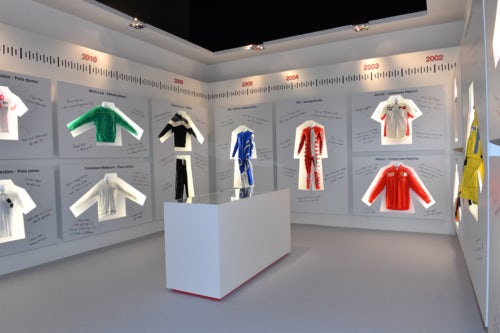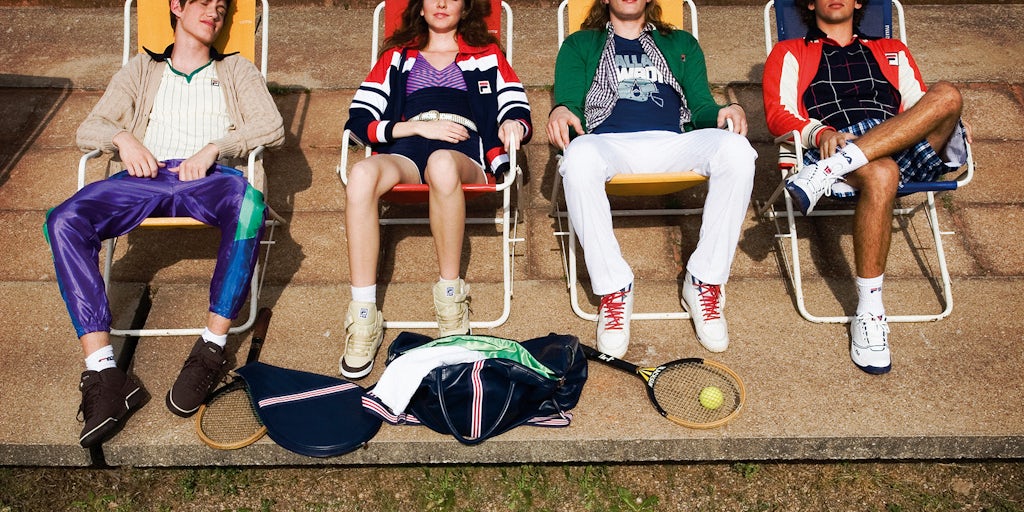MILAN, Italy — Milan has been in a nostalgic mood in recent seasons, with brands like Fendi, Versace and Prada looking forward by paying homage to their past. This season, as luxury Italian houses prepare to show their Spring/Summer 2019 collections, there’s one unexpected name joining the nostalgia-tinged fray: Fila.
For the first time ever, the Italian heritage brand, whose red, blue and white logo has been worn by everyone from school children to rap stars, is hosting a runway show at Milan Fashion Week. Designed by creative directors Josef Graesel and Antonino Ingrasciotta, who joined Fila this year from Adidas Originals, the collection will include womenswear, menswear and footwear.
The cult sportswear firm has enjoyed a renaissance as of late, thanks to the rise of athleisure and current trends, such as chunky 'dad' sneakers — a style the brand helped pioneer — and fashion’s love for the deliberately ugly, moving in its favour. Founded in 1911 — before Nike, Adidas or Puma — the brand fell on hard times after its '90s aesthetic fell out of favour and was eventually sold to its South Korea licensee Fila Korea for $400 million in 2007.
The show, taking place on Sunday, coincides with the launch of an exhibition at the Triennale Museum, which displays advertising campaigns, images and videos, charting Fila’s development throughout the years. Speaking to BoF, Fila chairman Gene Yoon said that the initiatives “represent a homage to our origins. Milan Fashion Week is one of the most relevant and contemporary platforms in terms of presence and visibility.”

The Fila exhibition at the Triennale Design Museum | Source: Courtesy
“Nostalgia is a major theme for retailers bolstered by the ongoing affair with 90s-inspired apparel and footwear,” said Emily Bezzant, head analyst at retail analytics firm Edited. “The trend among cult sportswear brands, who are reviving retro aesthetics, means that Fila is perfectly placed for a strong comeback.”
Indeed, Fila's hit sneaker of the 90s — the Disruptor — is one of the most popular women's shoes of 2018, according to fashion search platform Lyst (the shoe was the second most-search for item this year, only falling behind the Gucci logo belt). This April, the brand relaunched another famous shoe: the Mindblower. The shoe is sold by a wide range of retailers from Footlocker to Farfetch and is rarely discounted, indicating strong sales, said Bezzant.
According to Fila, its “heritage” category has grown exponentially and is now a key business driver for the brand, with sales of the segment up 146 percent in 2018. Every year, for the past four years, its heritage business has doubled. And while Fila tops are still the most stocked category across retailers, footwear grew from 19 percent of the assortment to 23 percent.
But now, Yoon wants to prove that Fila can compete in the world of high fashion. “Sportswear has become increasingly important in the fashion industry. It is what consumers are looking for nowadays,” he said. According to Yoon, Fila has always been intertwined with fashion and culture, citing “the visibility of the brand in The Royal Tenenbaums movie by Wes Anderson to endorsements from champions like [tennis player] Björn Borg, [and skiers] Ingemar Stenmark and Alberto Tomba.”

Vintage Fila campaign | Source: Courtesy
The brand has been gathering more clout in fashion in recent seasons since Russian designer Gosha Rubchinskiy, who routinely plumbs the '80s and '90s for inspiration, showed Fila-branded pieces on the runway in late 2016. According to Lyst, the Fila x Gosha Rubichinsky collection trended for weeks and sold out instantly each time it was restocked.
This February, Italian luxury house Fendi borrowed Fila’s typography for its Autumn/Winter 2018 collection, where logo-ed pieces retailed up to $7,300. Fila has also recently teamed up with New York-based brands like Jason Wu and Baja East.
Fila currently operates in more than 70 countries worldwide, with 37 licensees. For the second quarter of 2018, Fila Korea reported revenues of $706.2 million, compared to $619.8 million the same period a year prior. Operating profit for the quarter was $103.4 million, up from $72.9 million the same period a year ago.
Looking ahead, the brand is focused on tapping a new generation of consumers. Millennials and Generation Z drove 85 percent of luxury growth in 2017, according to consulting firm Bain & Co. By 2025, they are expected to account for 45 percent of total luxury goods spending. “Keeping pace with the younger generation, that’s one of the most challenging areas,” acknowledged Yoon. Indeed, Fila has just signed Borg’s 15-year-old son Leo, while rivals like Nike and Adidas dominate sponsorships of more established men's and women's players, and Uniqlo has just signed a 10-year, $300 million deal for Roger Federer.

Vintage Fila campaign | Source: Courtesy
The brand has been relatively popular among this demographic. According to Depop, a popular marketplace among millennials, Fila is among its top 25 brands this year in the UK alone. Global searches for the brand were up 34 percent from July to August 2018, while 2,000 different sellers around the world sold at least one Fila item on the platform last month.
Yoon noted that Fila needs to boost its online sales, which make up less than 10 percent of the total currently. Any significant growth, he said, will take at least another five years.
Matt Powell, vice president at the NPD Group, said Fila’s push towards fashion has been a smart move. “It brings Fila to another consumer and I think the younger consumer today is very interested in luxury brands as well.”
But there’s also more opportunity when it comes to tapping its archive.
“It’s not like there’s only two or three products Fila can bring back that are meaningful. There are hundreds of products to keep this retro thing extended for some time,” said Powell. “At the same time, there’s an opportunity to establish themselves in more of the mainstream market. Fila is hot and people recognise the brand, which gives them plenty of latitude to expand.”
According to Yoon, the brand’s presence in Milan “isn’t a one-time occasion,” he said. “Our heritage is so rich in inspiration that just one event won’t be enough to demonstrate our future.”
Related Articles:
Sorry, But Athleisure Is Not Dead
